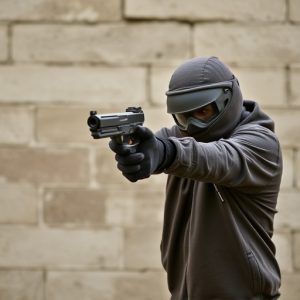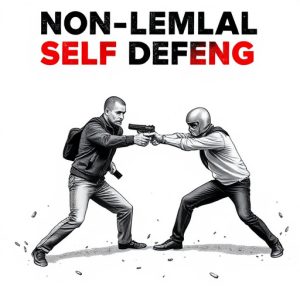Taser vs Stun Gun: Unlocking Urban Safety Differences & Best Choices
Stun guns and tasers, non-lethal self-defense devices, offer different approaches to urban safety. S…….
Stun guns and tasers, non-lethal self-defense devices, offer different approaches to urban safety. Stun guns use high voltage and range to disable attackers from a distance, while tasers employ lower voltage, higher current pulses through thin probes for close-quarters incapacitation. Choosing between them involves considering legal restrictions, power, range, durability, tactical grip, and training availability. For optimal urban defense, research local laws, select powerful yet legal devices with robust designs, and prioritize brands offering comprehensive user manuals and training to ensure safe, effective use of the best stun guns suitable for specific needs.
In the realm of personal safety, stun guns and tasers offer powerful tools for self-defense. Understanding the subtle yet significant differences between these devices is crucial. This article navigates the intricate world of stun guns, exploring their definition, functionality, and how they differ from tasers in terms of range, power, and effectiveness. We delve into legal considerations, safety guidelines, and key features to consider when choosing the best stun guns for urban safety, ensuring folks are equipped with knowledge to make informed decisions.
- Understanding Stun Guns: Definition and Basic Functionality
- Tasers: How Do They Work and What Makes Them Unique?
- Comparison: Range, Power, and Effectiveness
- Legal Considerations: Where Can You Legally Carry Each?
- Safety and Training: Who Should Use These Devices?
- Choosing the Best Stun Gun for Urban Safety: Key Features to Consider
Understanding Stun Guns: Definition and Basic Functionality
Stun guns, also known as electroshock weapons or Tasers, are non-lethal self-defense devices designed to temporarily disable a target through muscle paralysis induced by an electric current. These tools have gained popularity among individuals seeking urban safety options, offering a middle ground between conventional firearms and non-lethal alternatives. The primary mechanism involves firing two probes connected to wires, which deliver a high-voltage, low-current electrical pulse, disrupting the target’s neuromuscular system. This results in temporary immobilization, providing users with crucial time to escape potentially dangerous situations.
When considering the best stun guns for urban safety, it’s essential to understand their basic functionality and limitations. Stun guns are typically handheld devices, often resembling firearms or flashlights, making them easy to conceal and carry discreetly. They are designed to be simple to operate, with a trigger mechanism that allows users to fire the probes at close range. While stun guns are effective in neutralizing attackers temporarily, it’s important to note that their range is limited, typically around 2-3 meters, and they may not be as powerful as some might assume, depending on factors like the device’s voltage and the target’s body type and resistance.
Tasers: How Do They Work and What Makes Them Unique?
Tasers, officially known as Electro-Muscular Disruption (EMD) devices, are unique weapons designed to incapacitate individuals through a powerful electrical pulse. Unlike traditional stun guns that rely on high voltage and low current to temporarily disrupt motor functions, tasers use lower voltage but higher current pulses delivered through two thin probes. This technology allows for precise targeting of muscle groups, causing temporary paralysis and making the subject immobile.
What sets tasers apart is their non-lethal nature, making them a popular choice for law enforcement as a less-than-lethal (LTL) option, especially in urban safety scenarios. The ability to fire probes from a safe distance gives officers an advantage during high-risk situations. Moreover, the unique delivery system of tasers ensures that the current does not flow through vital organs, making them safer than stun guns while still providing effective immobilization for up to several minutes. This technology is crucial for de-escalating tensions and ensuring officer safety in dynamic environments, especially when dealing with resistant or aggressive individuals in urban settings.
Comparison: Range, Power, and Effectiveness
When comparing a Taser and a stun gun, both designed for personal defense, several key differences stand out—range, power, and effectiveness. In terms of range, stun guns typically offer a longer reach than Tasers, making them appealing choices for urban safety where distance from potential threats might be an issue. Stun guns emit a powerful electric current that disrupts muscle control, rendering the target incapacitated, often at a range of 15-20 feet or more. In contrast, Tasers generally have a shorter effective range, usually around 10 feet, as they fire small probes that must make direct contact with the target.
Power and effectiveness also differ significantly. Stun guns deliver a high-voltage, low-current electrical shock designed to temporarily paralyze without causing serious harm. Their ability to stun from a distance makes them effective against larger or more aggressive assailants. Tasers, on the other hand, use a lower voltage but with higher current, delivering a powerful jolt that can incapacitate even large individuals. They are known for their rapid-fire probes and short-range effectiveness, making them suitable for close-quarters situations where speed and precision are crucial, especially in urban environments where quick disarming is paramount.
Legal Considerations: Where Can You Legally Carry Each?
When considering the legal aspects of carrying a Taser or a stun gun, it’s crucial to understand that regulations vary widely across different jurisdictions. In many urban areas, both types of devices are subject to strict controls due to their potential use and impact on public safety. However, there are distinct differences in the legal landscape for each.
For instance, stun guns are often treated less restrictively than Tasers in certain cities, making them a more accessible option for individuals seeking urban safety solutions. Some regions permit open carry of stun guns with a valid permit, while Tasers usually require stricter regulations and may be limited to concealed carry or law enforcement use only. It’s essential for potential users to research and understand the specific laws in their area to ensure compliance and make an informed decision when choosing between a Taser or a stun gun as a means of personal protection.
Safety and Training: Who Should Use These Devices?
When considering stun guns or Tasers for personal safety, understanding the nuances between them is crucial. These devices serve different purposes and have distinct applications. Stun guns are designed to temporarily disable an aggressor with a powerful electrical shock, rendering them incapable of fighting back for several minutes. On the other hand, Tasers (or Conductive Energy Devices) fire two probes connected to a high-voltage, low-current electrical pulse, disrupting muscle control and causing the target to fall to the ground.
Training is an essential aspect when it comes to using either device. Due to their potential impact, stun guns and Tasers are not recommended for casual users or those without proper training. In urban areas where crime rates are high, law enforcement officers are typically equipped with these tools as part of their standard issue gear, ensuring they’ve undergone rigorous training in their use. Individuals seeking the best stun guns for urban safety should prioritize devices with a strong safety record and focus on brands that offer comprehensive user manuals and training programs to ensure responsible usage.
Choosing the Best Stun Gun for Urban Safety: Key Features to Consider
When it comes to personal safety in urban environments, selecting the best stun guns is a crucial decision. These devices offer a non-lethal way to deter and incapacitate potential threats, making them popular choices for self-defense enthusiasts and law enforcement alike. When choosing a stun gun for urban safety, several key features should guide your selection.
Firstly, consider the power output: Higher voltage outputs are generally more effective at stunning aggressors, but ensure it falls within legal limits to avoid accidental harm or criminal charges. Next, durability is essential; you’ll likely carry this device regularly, so a robust, reliable design built to withstand daily use is vital. Additional features like a tactical grip for better control and a compact size that fits easily in pockets or purses can also enhance practicality and convenience during emergencies.
When it comes to personal safety in urban environments, choosing the right stun device can be a game-changer. After understanding the fundamentals and exploring the unique features of stun guns and tasers, it’s clear that both have their strengths. Tasers offer a more powerful and longer-range option, making them ideal for law enforcement and those seeking maximum deterrence. Stun guns, on the other hand, are smaller, easier to carry, and provide a quicker response time, making them a popular choice for urban dwellers who want immediate protection without long-range capabilities. When selecting the best stun gun for urban safety, consider factors like ease of use, durability, and legal restrictions in your area. Investing in a quality device can empower individuals to protect themselves effectively in today’s bustling metropolis.


